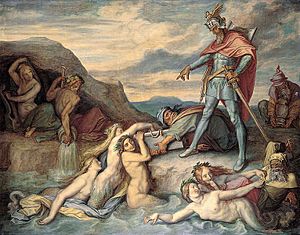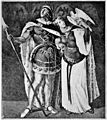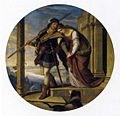Nibelungenlied facts for kids
The Nibelungenlied (say: Nee-beh-loong-en-leed) is a very old and famous German poem. It's like a long story told in verses, called an epic poem. The name means The Song of the Nibelungs. It tells the exciting and sometimes sad tale of a hero named Siegfried, who was known for slaying a dragon. The story also follows his wife, Kriemhild, and her quest for revenge. This revenge leads to many deaths, including her own.
The story of Siegfried was also used in a famous opera series called Der Ring des Nibelungen by Richard Wagner. In this story, "Nibelung" can mean "dwarf".
The Nibelungenlied is based on even older tales. For a long time, these stories were part of an oral tradition. This means they were told aloud from person to person, not written down. During the Middle Ages, people started writing down more and more stories. Today, we have about 35 German copies and one Dutch copy of the Nibelungenlied. The very first written copy, called the original manuscript, has been lost.
The three oldest copies we have are called A, B, and C:
- A - The Hohenems-Munich manuscript was made in the late 1200s. You can find it today in the Bavarian State Library in Munich.
- B - The St.Gallen manuscript was made in the mid-1200s. It is kept in the Abbey library of St. Gallen.
- C - The Donaueschlingen manuscript was made in the early 1200s. It is now in the Badische Landesbiblithek in Karlsruhe.
Copy B seems to be the most like the lost original. However, we don't really know how these three copies are connected. The Nibelungenlied was probably told in many different ways because it was an oral tradition. It's hard to know how these spoken versions changed the written ones.
Manuscripts A and B end with the words daz ist der Nibelunge not, which means "that is the fall of the Nibelungs." Because of this, they are known as the Not versions. Manuscript C ends with daz ist der Nibelunge liet, meaning "that is the song/epic of the Nibelungs." This is why it's called the Lied-version. The C text was changed a bit to be more popular with people at the time. It is less dramatic. Many people think the B text was the most artistic for its time.
Who wrote this epic poem?
We don't know the name of the person who first wrote down the Nibelungenlied. The original copy is lost, so the author remains a mystery. However, some people have suggested a few possible writers:
- Der von Kürenberg: He wrote poems that were very similar. One of his poems, the Falkenlied (falcon's song), is like a dream Kriemhild has in the Nibelungenlied. But most experts think he lived before the Nibelungenlied was written.
- Walther von der Vogelweide: He used words that were similar to those in the Nibelungenlied. This might be because he lived in the same area. However, his main ideas were very different from the ones in the Nibelungenlied.
Other ideas, like an unknown nun from a monastery in Passau, are usually not taken seriously by researchers. This is because there isn't enough proof to support them.
The poem's beginnings
The Nibelungenlied starts with some famous lines. However, these lines were probably added later and were not in the very first written version.
| Middle High German original | English translation |
|---|---|
|
Uns ist in alten mæren wunders vil geseit |
Many wonders are told to us in old stories, |
The original poem likely began by introducing the main character, Kriemhild:
| Middle High German original | English translation |
|---|---|
|
Ez wuohs in Burgonden ein vil edel magedîn, |
There once grew up in Burgundy / a very noble maiden, |
You can find English translations of the Nibelungenlied online, for example:
- The Nibelungenlied: Translated into Rhymed English Verse in the Metre of the Original by George Henry Needler
Images for kids
-
"Siegfried's Departure" (Julius Schnorr von Carolsfeld, c. 1843)
-
Hagen orders servants to sink the hoard in the Rhine (Peter von Cornelius, 1859)
See also
 In Spanish: Cantar de los nibelungos para niños
In Spanish: Cantar de los nibelungos para niños







